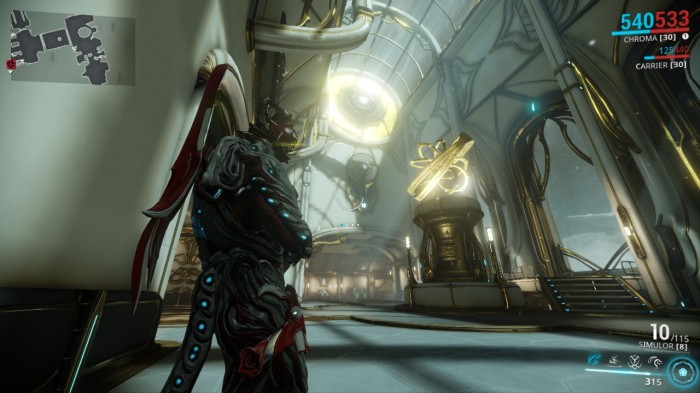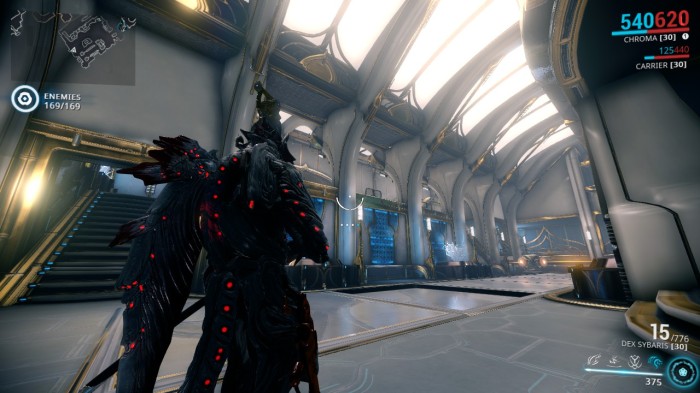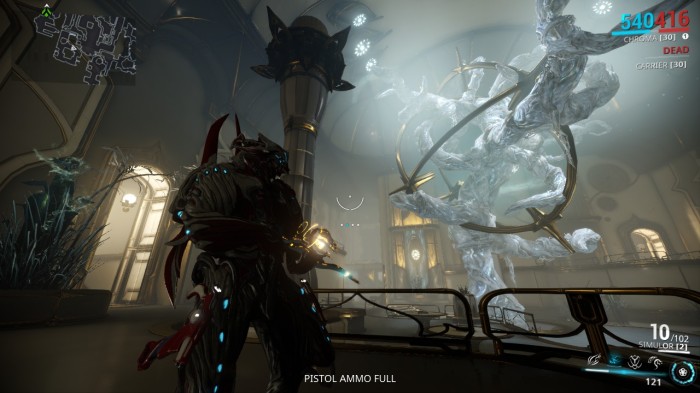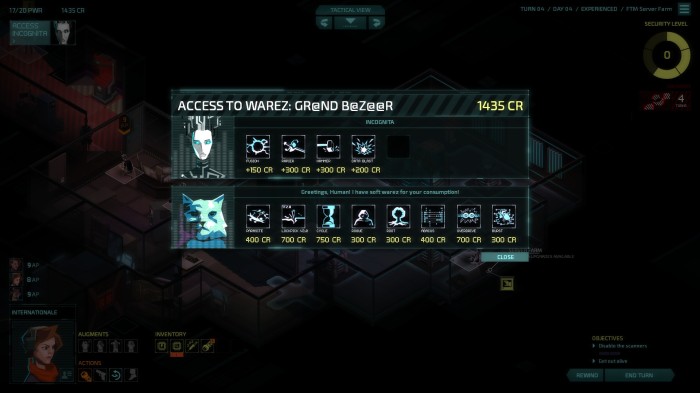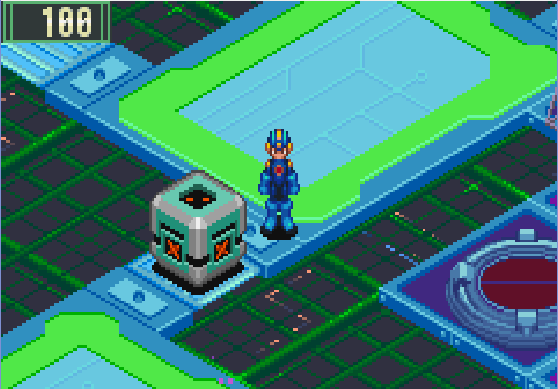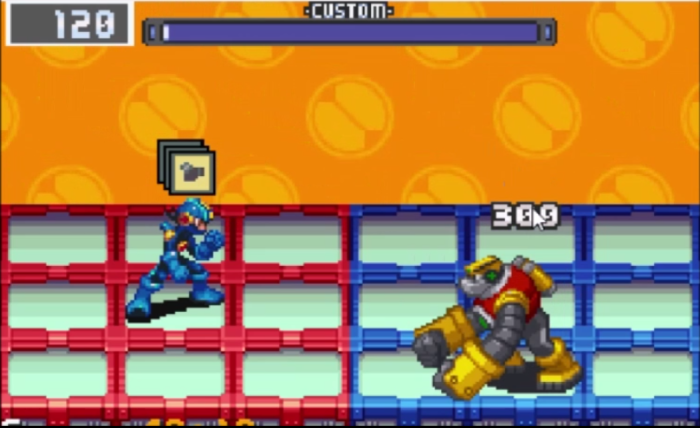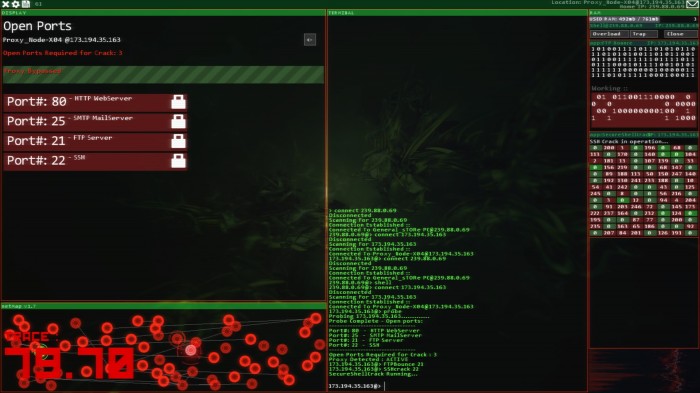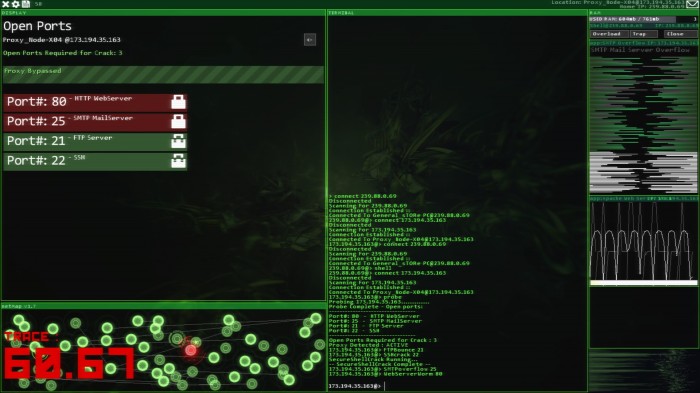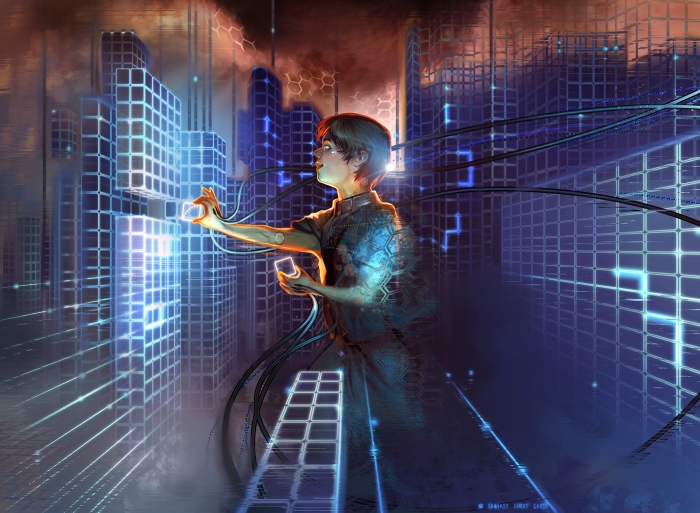WARNING: THIS ARTICLE CONTAINS SPOILERS FOR THE ENTIRE CAMPAIGN OF TERMINAL DIRECTIVE. IF YOU HAVE NOT FINISHED THE CAMPAIGN YET, DO NOT READ THIS ARTICLE.
So I just finished the new campaign expansion for Android Netrunner, called Terminal Directive, and I have to say my feelings are…mixed. When I read the announcement post for this expansion back in November of last year, I was super excited about the idea. A deluxe expansion that doubles as a legacy game? Sounds like a great idea to me! And it turns out, despite my many criticisms, it is a great idea! That said, any future campaign expansions definitely have a lot of improvements to make, which I will expound on shortly. Do keep in mind though that I have some praises for the expansion as well, alongside the fact that there are a few flaws I believe are more theoretical than solid fact. And now that I’ve gotten all that out of the way, let’s delve into what makes Terminal Directive tick and not tick.
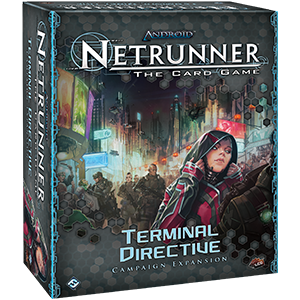
Part 1: The Gameplay
The first and most important aspect to discuss is the gameplay of Terminal Directive. In truth, the general gameplay is not that different from Netrunner. There are a few cards both sides in the game have to auto-include in their decks, some positive and negative effects each player will have to deal with throughout the game from their PAD, and eventually a few more campaign exclusive cards players can choose to include in their decks or not. But despite all of this, core gameplay and strategies largely stay the same. This means you essentially have two players building their decks and strategy around just one core set and the expansion, alongside some slight buffs or de-buffs which can affect them. As a result, the main subject to analyze here is how balanced the gameplay is between the runner and the corp, both when it comes to the card pool as well as the potential PAD effects throughout the game.
Now before I continue, a couple caveats. I only played through the campaign once, with myself as the Shaper and my brother as Weyland. This means I don’t know exactly how powerful Haas-Bioroid or the Criminal runner can be in the campaign, though I believe I still have a general idea. Also, each individual person’s experience with the game will also heavily depend on the difference in skill level between the two opponents, how they agreed to play the campaign, as well as, obviously, some luck. I personally believe my brother and I are of fairly equal skill-levels, particularly when he’s the corp and I the runner, and that our shares of luck were pretty equal, but you will likely have a different experience if your opponent is far better or worse than you, not to mention if one side consistently gets some bad luck. Though I believe these factors (opponent skill variance and bad luck) can and should be mitigated for maximum enjoyment, they may cause differences in mine and other’s opinions of the game. Also, my brother and I agreed to role-play the campaign, meaning that when we had to make an ethos choice, we couldn’t see what the consequences would be before choosing. I personally believe this helps keep things more interesting for the game and I would highly recommend it, but I don’t think it mitigates, by much, the general imbalance in the game.
Alright, let’s start this analysis by my giving you a mini-report on how each of the games went in my campaign. Please note that with every victory my brother and I had we managed to score at least one of the campaign cards required to move to the next set.

Game 1: Weyland wins fairly handily, though I found out after Game 2 that I was three influence points over the legal limit during this game due to my not noticing Process Automation costs 1 influence a piece, so I’m rather glad he won in terms of fairness. My deck was based around building up a breaker suite of Gordian Blade, Battering Ram, and Ninja, with Maker’s Eye for R&D access and Stim Hacks for emergency remote server runs. My brother’s was largely focused on scoring with a chance for tag-and-bag with ICE like Data Raven, and his particular strategy in agenda protection revolved around annoying sentry ICE to trash all my programs.
Weyland: 1, Shaper: 0
Game 2: I won this game, and due to some deck tweaks I made between this one and Game 1, I was only 1 influence point over my legal limit, so it’s mostly fair.
Weyland: 1, Shaper: 1
Game 3: After realizing my influence mistakes the past two games, my deck is properly legal, but Weyland wins again with relative ease. It should be noted that I also triggered both my cautions this game while my brother has avoided his with relative ease, which makes me feel rather distraught at this current time.
Weyland: 2, Shaper: 1
Game 4: Starting to realize my current deck isn’t doing very well, I completely revamp it to take advantage of the new free MU strategy the Shaper cards introduce in Terminal Directive. This means changing my entire breaker suite to just Savant and Corroder on Dhegdheers while using Deep Data Mining for better R&D access and Levy University Lab for quick rig set-up. Needless to say, this deck was far better and more efficient than my last one, but it didn’t matter much this game since my brother got some horrible agenda flooding. I also got quite lucky by being able to eliminate early in the game both of the problem cards my cautions introduced.
Weyland: 2, Shaper: 2
Game 5: Despite the agenda flooding, my brother still saw how scary my new deck was, so he switched out most of the sentry ICE for expensive ICE like Hadrian’s Wall and Archer while also putting more of a focus on tagging and bagging. One Posted Bounty and two Scorched Earths later, and I was flatlined.
Weyland: 3, Shaper: 2
Game 6: At this point, my brother is at the final chapter in the campaign, meaning all he needs to do is score 9 agenda points over the next game or two in order to essentially win the campaign. So in other words, he has a head start on the agenda points race. I put in a few more tag-and-bag counter measures to my deck, and after an incredibly long game I finally pull out a win. My brother also triggers the caution that occurs after he ends his turn with 20 credits or more, and while the newly brought out card is a thorn in his side for the last two games, it doesn’t make too much of a difference.
Weyland: 3, Shaper: 3
Game 7: My brother hits on the realization that he should put a few Snare! cards in his deck to try and punish my Deep Data Mining. Meanwhile, I’m now in my final chapter of the campaign as well, and I come just short of 1 agenda point from winning the campaign by stealing a total of 8 agenda points for the victory.
Weyland: 3, Shaper: 4
Game 8: Despite getting to use the cards he got from losing 4 games, my brother doesn’t need them and proceeds with little changes to his deck. I know Snare! will be a huge problem for me, but I fail to remember it’s one counter, Bio-Metric Spoofing, and so I hardly change my deck as well and hope that luck will be on my side. After hitting a Snare! two different times early game without a single agenda stolen, the game is soon over after another tagging-and-bagging (but not before an Evidence Collection is scored).
Weyland wins the campaign.
My Thoughts:
In truth, this is probably about as good a run as could be had with the campaign. In fact, it sounds like I should be extremely thankful (which I very much am). I’ve heard of many other people getting completely crushed by their opponents, with games ending with a 1-5 or a 0-5. My campaign with my brother was pretty much neck-and-neck, with the final game being a true final showdown that, admittedly, we both had a pretty good chance at winning. So while our game experience was nowhere near as horrible as some others, and perhaps is even the ideal way for a campaign to run, I still felt like it didn’t go as well as it could have. And this feeling is a result of the imbalance I believe lies in the campaign’s design.
You see, in nearly every round where I won a game, I never felt like I won the game easily. They all pretty much came down to the wire, and while these kinds of tense thrills and final gambits are quite fun and fit the theme of being the runner incredibly well, it just felt odd that on the flip side the corp’s victories generally felt…easy. This isn’t to say that my brother won due to his lack of skill or my not making any mistakes, since he played quite skillfully and I admittedly made some rather big mistakes a few games. That said, it rarely seemed like my brother was on the ropes during our matches. Obviously he was in big trouble when he had that agenda flooding match, and there was one game where he was destitute for credits for a while, but every other game, whether he won or lost, it seemed to me like he wasn’t in that sticky of a position. Whether it was his never ending mountain of credits, his crazy powerful campaign cards, his small and low value agenda pool, or even some incredibly convenient PAD effects, it always seemed like the advantage was largely in his favor. Let’s break down each of these factors in comparison to the runner’s. Once again, due to ethos choices causing different combos to occur, it’s possible for other people’s campaigns to play out slightly differently, so take some of these criticisms with a grain of salt.
1: Credits
With cards like Hedge Fund, IPO, and Beanstock Royalties, my brother was never short on credits. Almost every single game, I would watch him play two to three of these operations in a row fairly early on, meaning his ability to easily defend any of his servers with unrezzed ICE increased immensely every game. Meanwhile all I could do was try to keep enough credits around to build up my rig. While games where I could get Magnum Opus out early did help keep my credit pool pretty healthy as well, games without early money-making ability caused my rig-building to suffer greatly, all while I watched my brother’s servers get more heavily ICE’d and his credit pool grow ever bigger. However, if my brother only had access to the previously mentioned credit-making operations, at least his long-term stability would be shaky, right? Enter Marilyn Campaign. A card so good I expect it will see lots of play outside of the campaign as well. What makes this card so good is not just it’s money making ability, one influence point, and reasonable rez and trash cost, but also the fact that if it’s trashed when installed, it goes back into the corp deck, which not only helps keep the deck density up, but ensures more money making will be on its way. This card was one of the banes of my existence, since the only time it was really worth trashing was immediately after it was rezzed, but since this meant the card going back into R&D, was it really worth it? Perhaps more experienced runners would always say yes, but for me the cost of trashing it and possibly having to get through some ICE first was rarely worth the effort. While the credits from Marilyn Campaign didn’t always get to help fatten my brother’s wealth, it was still another surety that keeping his credit pool dry would be a near impossibility.
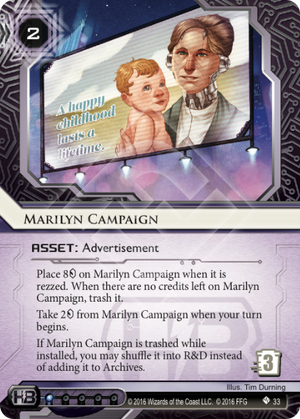
Corp: 1, Runner: 0
2: Campaign Cards
Let’s compare each card that the runner and corp get in each part of the campaign, respectively, and try to determine which card seems to have a generally higher power level, particularly when combined with other cards.
Set 1
Corp Card: Evidence Collection
Right from the get go this card is quite excellent. While it does force the corp to build their deck around three 2 point agenda’s the entire game, these 2 point agendas can be scored after a mere 3 advancement tokens are placed on them. Agendas like this are hard to come by in normal Netrunner due to the kind of power they afford. A corp can easily place one of these face down in a server, meaning to the runner it could be just about anything, and then instantly advance and score it next turn (and let’s not forget installing and scoring it in one whole turn with Biotic Labor). But this agenda gets worse. While it doesn’t change with every victory like it’s runner card counterpart, it’s final form states that the agenda is only worth 1 agenda point to the runner. This is crazy. While stealing the agenda before was decent for the runner since they denied the corp an easy score, the fact that it’s value is reduced to 1 point means the runner is going to have to work even harder during a point in the game when they already have plenty of other things working against them.
Runner Card: Investigator Inez Delgado
Inez is a card that, in my opinion, starts off pretty weak, and doesn’t become truly powerful until set 5. Her previous abilities to reveal cards in a remote server or the top three cards of R&D, while somewhat helpful, aren’t that great when you consider you likely spent all your credits scoring the agenda that allowed you to trigger her effect in the first place, meaning any other agendas revealed can’t be immediately chased after either. Getting to eventually look at your opponent’s hand is quite useful though for a multitude of reasons, but even this info, while powerful, isn’t as useful in my opinion as the corp devaluing one of their agendas for the runner, especially since the runner doesn’t have access to Leg Work if you play Terminal Directive as recommended.
Verdict: All in all, I’d have to say the corp’s card from set 1 is the better one overall.
Corp: 2, Runner: 0
Set 2
Corp Card: Investigator Inez Delgado/Lt. Todachine
Depending on which ethos choice the corp takes, they’ll only have one of these cards. But in all honesty, I believe both are amazingly helpful. While Lt. Todachine is obviously more of a nightmare to deal with against Weyland because of Scorched Earth, a wealthy Haas-Bioroid can still easily trash any resources a tag-flooded runner has, meaning the Lieutenant is still a pain either way. My opponent got Inez in our campaign however, so I’ll discuss her power more, which is, frankly, quite incredible. Due to Inez’s ability to swap agendas with the runner, first when you score them and then when they’re stolen, this makes the previously mentioned card, Evidence Collection, only being worth 1 point to the runner, as well as the 0 point agendas that can be added with set 9, even more of a drag, not to mention her ability to activate the swapped agenda’s “when scored” ability. Oh what’s that? You thought you were going to steal one of my 2 to 3 point agendas? Here, take this 1 to 0 point one instead. Thanks for possibly bringing me closer to victory! Oh, and that Armored Servers you were hoping to negate by stealing is now not only mine, but live and dangerous. Lastly, don’t forget that if you want to get rid of me kid, you’re going to need at least 5 credits, barring any ICE in front of me.
Runner Card: Surveillance Network Key (SNK)/BMI Buffer
SNK is nice since it makes the corp nervous to draw more cards, and it’s upgraded effect can give a mini-Leg Work or Maker’s Eye ability to the runner later on. However, it’s more MU that must be used up, another card slot taken, and while it’s helpful, I don’t think it’s as helpful as the corps possible cards (Inez/Lt.) can be. BMI on the other hand is, in my opinion, a bit worse than SNK. While it can help save some essential programs trashed by an unlucky run-in with a Snare or some ping damage from the likes of Mr. Stone, it’s starting effect is still incredibly situational. It’s boosted effect, which allows a hosted program to be installed for free (minus two clicks) does make it something a little more worthwhile if you’re short on credits since you can just trash a program from your grip to get it hosted. Unless of course you’re playing against Skorpios, in which case this card becomes pretty worthless. Let’s just say I’m glad I got SNK during my campaign.
Verdict: Once again I’d have to say the corp has the better cars here. SNK is useful, but I still believe it and certainly BMI Buffer are far too situational compared to the corp cards. Inez and Lt. Todachine are incredibly beneficial to either corp against either runner.
Corp: 3, Runner: 0
Set 6 & Set 7
Corp Card: Machicolation
A piece of ICE that is pretty nasty to face check into, though one more so than the other. The protector version of this ICE is painful, with two trash 1 program subroutines, 1 trash a piece of hardware subroutine, and a subroutine that makes the runner lose 3 credits and end the run. While it is expensive to rez at 6 credits when it’s only at 4 strength, I mentioned before that the corp is rarely at a loss for credits, so this isn’t much of an issue. For the runner, this ICE is going to cost around 4-6 credits to break, which is nothing to sneeze at cost wise. While the predator version of this ICE isn’t as game ruining for the runner, being able to freely trash resources is nice, and making the runner lose a click can be beneficial to Sedir in particular. Overall though, I’d have to say this piece of ICE is quite excellent for either corp in either form. The protector form is definitely more powerful and the predator, but even so, either piece of ICE will give the runner some serious trouble.
Runner Card: The Masque
The Masque is, like BMI Buffer, situational at best in either form. Her protector form essentially allows you to make a free run and draw a card if it’s successful, while her predator form allows you to make two free runs if the first is successful. While the card is thematically appropriate (the runs are free because the Masque is doing them for you), the benefits of either of it’s versions aren’t anything that spectacular, particularly for the Shaper. I had the protector version of Masque, and I quickly questioned why I should bother slotting in a card who takes a credit and a click to set up just to essentially get a (one-time) free card draw when I could simply spend a click to draw three cards with Diesel. I even had a PAD effect that allowed me to draw a card if a run on my first click was successful, meaning the Masque could let me draw 2 free cards, but again, why not just use Diesel instead? While the Masque in either form could certainly be more useful for the Criminal runner due to cards like Bank Job, I still feel like even then she wouldn’t be not that much of a power boost. Not when compared to the power boost the corp gets from their new piece of ICE.
Verdict: If you couldn’t guess, I once again believe the Corp has the better card here. The Masque’s effects just seem too minuscule overall, and while the new ICE might not be a necessary include for some corp decks, it’s still a very viable one due to its incredibly nasty effects.
Corp: 4, Runner: 0
Set 9 (Emergency Cards)
Corp Card: Corporate Oversight
At face value, this card isn’t all that good. While it does allow the corp to freely install and rez any piece of ICE in front of a remote or central server (depending on which version of the card the corp gets), there’s a few problems with this. First, as I’ve mentioned before, the Corp doesn’t seem to starve often for money in the campaign, meaning the only benefit this agenda offers is digging up some expensive ICE you haven’t drawn yet. Second, since it’s an agenda that doesn’t help your agenda score count, this means it’s taking up valuable deck space another operation or piece of ICE could be taking instead, deck space that can be permanently made smaller, I might add, if the runner steals one of them. Data Dealer or Shadow Net + Sure Gamble never looked so good right now. That said, I did mention earlier that you could use this agenda against the runner with Inez to make their agenda score as small as possible, which helps boost this agenda’s power. Still, I’d argue this agenda isn’t that helpful should you have Lt. Todachine instead, and even with Inez, you’re still going to have to sacrifice some cards for a combo that might help you if you get Inez out before the runner can sell off your worthless agendas.
Runner Card: Sneakdoor Prime
While incredibly expensive to install, both credits and MU wise, these cards are quite powerful in either form. While, just like Sneakdoor Beta, the element of surprise likely won’t last for long, forcing the corp to ICE up weakly protected (if protected at all) Archives or remote servers is very beneficial for either runner. While I think this program might be a bit better for Shaper (hello Dhegdheer), it could certainly be a valuable tool for the Criminal runner as well, at least for a while, due to their nasty tricks. Sadly, I never got to open this set during my campaign, so I never got to experience just how useful they could be.
Verdict: For once, I’d say this time the runner has the better card this time around. While I don’t think Corporate Oversight is absolutely terrible, I can see why a lot of corp decks just wouldn’t want to include it.
Corp: 4, Runner: 1
Set 3 and 4 (The Caution Triggered Cards)
Corp Cards: Trojan and Security Leak
Now we’re dealing with the cards that have negative effects. For the corp, these effects are annoying, but not necessarily devastating either. Security Leak makes advancing your first agenda doubly expensive, but if you score it you won’t have to likely worry about the current event for the rest of the game. Since you can have cheap agendas like Evidence Collection, Accelerated Beta Testing, Hostile Takeover or Posted Bounty in your deck, you can also help mitigate how many credits you’ll have to spend on said agenda. And so long as the runner doesn’t steal the agenda, you should be able to get into the clear early on into the game. This card is more of a nuisance for Weyland though since it makes it harder to advance their ICE, which is worth noting. However, I should also mention what has to be done to get rid of each card permanently, and for the corp, it’s going to be pretty tricky to destroy Security Leak. The corp just has to end their turn with no cards in hand, but since they often need to hold key operations, ICE, and agendas in said hand, not to mention draw one new card every turn, this is easier said than done. While it’s not impossible for the corp to empty their hand, it’s going to be tricky for most corp players to permanently remove this thorn from their side.
Trojan on the other hand, well, doesn’t seem too bad at first. But when you consider the fact that it’s three cards forced into a deck that can only have so many cards per agenda density, then you’ve got a real nuisance. Now my opponent never triggered the caution that would have required him to include these cards in his deck, meaning I never got to see it’s full effect, but it’s clear that forcing the corp to lose 2 credits and even worse, discard 1 random card from HQ, would have been annoying to deal with. At least if a Trojan’s effect goes off it does get permanently destroyed, but whether the corp destroys the Trojan’s by letting them fire or by installing seven pieces of ICE in total in front of their central servers, this is certainly a hamper on either corp’s strategy.
Runner Cards: Shadow Team and Net Watchlist
Net Watchlist is definitely a larger thorn in the runner’s side compared to Security Leak, particularly since the runner in TD typically struggles with obtaining credits more often than the corp, alongside the fact that every run against ICE isn’t guaranteed to give the runner the agenda needed to trash the operation. Thankfully, to permanently remove the operation, the runner just has to empty their hand, which is incredibly easy to do in most situations. Honestly, even if it means trashing an event or two, the runner can often afford to empty their hand a lot more often than the corp can.
Shadow Team is also little more than a minor annoyance. Granted, if the corp decides to try and make things harder on you by ICEing all their central servers, then there might be more of a problem. But since you can often permanently get rid of Shadow Team by just hitting Archives at the cost of trashing a card of your choosing, this “penalty” for springing it’s caution likely won’t last for long. Now to be fair, this card is going to be more of a problem for the Criminal since it’s alternative destruction effect, steal 2 agendas in a single run (if I recall correctly), is going to be incredibly hard without cards like Maker’s Eye and Deep Data Mining. Still, it’s single card destruction effect is relatively easy to pull off, especially with cards like Inside Job.
Verdict: Though I’d say these cards are pretty even in their nastiness, if we’re going to decide who has the advantage due to their penalties being weaker, I’d say the runner does since they can get rid of their penalty cards more easily.
Corp: 4, Runner: 2
So that covers all the campaign exclusive cards. As you can see, the corp is already in the lead, but we’re not done with comparisons yet, so let’s move onto the next subject: PAD effects!
PAD Effects
This is certainly the part of my critique that’s bound to have the most various types of opinions due to the many possible paths each person’s campaign takes. As such, while I cannot claim my critiques are solid fact, I do believe their general rulings are likely to be true. So without further ado, let’s examine each PAD effect in their three separate categories: Ethos effects, Cautions, and Tasks.
Ethos Effects:
Ethos effects are the main ones you have during the campaign. These are the stickers that reside in slots A through D, and they are all generally permeant effects for your side of the campaign. So how do they compare?
Corp Ethos: The corp’s power is actually quite binary depending on which ethos effect the corp decides to choose. If the corp chooses Protector, their power increases immensely. With powerful card draw, recursions, and credit gaining abilities, a protective corp is a real pain to deal with. My brother chose mostly protector effects, and one in particular made beating him quite difficult. Essentially, if I did not make a successful run on my previous turn, he would get 2 credits at the start of his. As if he wasn’t already swimming in credits, this insane effect helped ensure his financial stability even further. However, had my brother chosen mostly predator effects, it would seem his power would have been reduced greatly. While I wouldn’t say the predator PAD effects are horrible, they aren’t all that helpful either, particularly when compared to the protector versions.
Runner Ethos: Unlike the corp, it would appear the runner’s ethos effects are about equal for both sides. However, one weakness I find in them compared to the corp’s is the lack of recursion, or rather, the lack of ease of recursion. While the predator effect for slot A on the runner’s PAD can offer a little bit of recursion, it’s not much either. And while a predator effect for slot B can possibly give the runner some strong recursion, it’s still limited by how well the corp can keep 3+ remote servers up. Compare that to two recursion effects the corp can get, one which allows them to place a trashed card under R&D if the runner is tagged (meaning Snares can never be truly rid of if sprung), and another where the corp can shuffle a card from Archives into R&D if the runner isn’t holding cards equal to their maximum hand size. The reason this seems like such a punch in the gut for the runner is that the runner often needs recursion more than the corp, so making it easier for the corp to get useful cards back only makes things worse. And since the only recursion available in a TD campaign through other means is Déjà Vu if you’re Ayla, or Steve Cambridge’s natural but high cost ability that allows the corp to decide which card he retrieves and which one he loses forever, this hardly feels fair to the corps similar but easy option of Archived Memories should they really need some recursion.
Verdict: While I would say in some ways both sides are fairly close, I find the corps odds of getting some nice recursion compared to the runner getting fairly poor recursion, if they get it at all, heavily favoring one side over the other. As such, I’d say the Corp wins this one.
Corp: 5, Runner: 2
Cautions:
I judge the cautions by how easy it is to trigger them. The easier it is to trigger one, the worse that trigger is. You can probably guess where this is going.
Corp: The corp’s triggers encourage the corp player to stay under 20 credits at the end of their turn and to not click a second time to draw a card. While these are minor inconveniences, they’re not a huge hamper in the corp’s playstyle either. Regarding the first caution, 20 credits is still nothing to scoff at. Plenty of ICE can be rezzed and operations triggered for that amount. Would the corp like to hold more than that? Sure! But 20 credits isn’t that heavy of a limiter either. For example, while my brother would have the occasional hard time keeping himself under 20 credits (how painful it must be to limit your own wealth), he was generally able to avoid triggering the caution. And though one game he did eventually trigger it, partially for fun, the resulting card, as previously discussed, wasn’t too much of a hamper on his playstyle. I honestly believe a limit of 15 credits would have been a better caution. As to the other caution though, that’s an even easier one for the corp to avoid. It’s considered general knowledge that as the corp you shouldn’t be drawing for too many cards over the course of the game, mostly to avoid agenda flooding. While my brother was tempted to use a second click to draw a card on occasion, I don’t think caution limit hurt his overall gameplay at all. And I doubt it hurt most other corp players in the campaign either.
Runner: The runner’s triggers on the other hand, were rather insane. The first asks you to make at least one run every turn, while the other asks you to keep at least 3 credits in your credit pool at the end of your turn. Any runner knows that either of these tasks is an incredibly difficult and playstyle hampering thing to do. Every click and credit is precious, so cautions asking you to not spend your last 3 credits or make a futile run every turn is rather ridiculous. I triggered both of these within my first two or three turns during my first game with them, and while I was happy my next game got rid of the resulting cards quickly, I was still mad my cautions were so game limiting while my opponents were hardly a problem.
Verdict: In case it wasn’t already obvious, the corp’s cautions are better than the runner’s.
Corp: 6, Runner: 2
Tasks:
There’s actually not much of a comparison to make here. While I was a little mad the runner’s tasks were generally easier to trigger but also not able to be chosen when to fire (meaning I could blow free credits on a game where I didn’t need them), the corp’s tasks are also fairly unwieldly and don’t have that great of effects either. The fact that my brother never, as far as I know, had a reason or a chance to fire his first task in slot G is evidence towards that. I’d say this comparison is a draw.
Corp: 5, Runner: 2
With the PAD effect’s out of the way, there’s just one more gameplay critique to make, and that’s about the corp’s agenda density!
Agenda Density:
Both corps have the opportunity to give the runner a hard time when it comes to stealing agendas. Due to the fact that each corp gets access to two new 2 point value agendas in TD, they can easily have a deck consisting of nine 2 point agendas and two 1 point agendas. This means the runner has to steal a least a total of 4 agendas to win, which matters immensely. Not only does this mean the runner will have to make critical runs a whole lot more (and get even luckier with cards like Deep Data Mining), but this also gives the corp a whole lot more time to ICE up their servers and/or set up traps to kill the runner with. Since the corps already have the advantage in TD with loads of credits, powerful ICE, assets and operations, as well as possibly some strengthening PAD effects, the pressure for the runner to not make any mistakes is immense, making the ease of having low agenda density just the icing on the cake. While the corps can certainly choose to add some 3 point agendas to their deck instead, I believe the huge advantage of having just 2 and 1 point agendas is far better, especially when their “when scored” abilities are so nice as well.

Corp: 7, Runner: 2
So there you have it. The corp’s score is a game winning 7 agenda points in this comparison. While I’m not necessarily adamant that the corp’s advantage is this huge compared to the runner, even if you shaved a few points off and gave them to the runner, the corp would still have an advantage. Due to both the design of the limited card pool and the general PAD effects, I believe the corp has been dealt the better hand in this campaign. Now it should be worth noting that this isn’t necessarily a bad thing, since it’s certainly feasible to imagine story wise why a corp might have the advantage over the runner. I could certainly understand why Haas-Bioroid would invest considerable resources into making sure the loose bioroids are contained quickly, particularly if Haas-Bioroid is primarily or partially responsible for the bioroids, which would also mean they’d have an advantage in information. However, considering Weyland’s motivation for finding the bioroid is primarily to integrate it’s unique brain into their own AI combat systems, I would think they shouldn’t have much of an advantage over the runner since both sides just found out about the bioroid by accident. Yes, Weyland is a corp with loads of employees and cash, but even the story makes it clear you only control a small department working on this case, perhaps even during just a part of the day. The runner is someone who can spend all their time and resources chasing down this case, hence the reason both sides should be about even in power. Considering this poor match-up story wise, alongside the fact that the rulebook doesn’t let players know beforehand that one side does have an advantage over the other, I’d have to say this imbalance in power is a bad thing. While I would also say it’s rather debatable to make a campaign where one side has an advantage over the other (particularly in a two player game), at least if FFG wishes to do so again moving forward (assuming it’s on purpose), they should let the players know ahead of time. Playing the underdog in a two-player game over multiple sessions is already bad enough, but not even knowing you’re playing the underdog until it’s too late is even worse.
Now that I’ve given my critique of the gameplay though, let’s talk about what was done right. Beyond the general gameplay of Netrunner, which is solid as always, there’s one aspect in particular that I found more exclusive to the campaign that I believe is quite a positive thing. Namely, the constant tweaking of your deck to counter you opponent. When you’re normally building a deck for Netrunner, though you certainly try to include cards to help reinforce your strategy while stopping your opponents, you typically have to build a deck that tries to account for all types of opposing strategies and/or weaknesses. In TD however, your opponent is stuck to just one faction and ID, meaning their range of options is more limited. This spurs both more focused and yet more creative deck building. A good example of this my campaign against my brother. Though our first two games were mostly us just trying to beat each other, it wasn’t long before we were both revamping our decks nearly every round, sometimes in very heavy ways, in order to account for a new weakness or strength we spotted. This actually felt really cool since it simulated the constant struggle between a corp and a hacker trying to one-up the other in terms of strategy, technique, and technology. It also helped, speaking for myself at least, you feel better after a loss since you could take out cards you felt weren’t helping to give you a feeling of a renewed fighting chance next game. The fact that you’re also able to perfectly refine your deck over the campaign is loads of fun too. The only potential gripe I have about this type of competitive gameplay is that it can possibly determine the winner within the first round or two. Once one side has the first or second victory under their belt, the game of constant back-and-forth surprises and victories could potentially mean, in the end, that the winner in the beginning is ensured to be the winner in the end (since the loser is the first one who must start to counter just to catch up). Perhaps this isn’t/wasn’t a problem for most people, but if counter-strategies can be nearly fool-proof every time they’re first sprung, a game of “victory tennis” isn’t very fun for the player who knows they didn’t get the first serve. That said, I wouldn’t exactly know the solution to this problem, if it even is one. Perhaps the secret to making sure the new deck you just revealed isn’t hard countered is to try and think ahead of your opponent and what they might change to counter yours, and then counter accordingly. It’s mind spinning stuff, but it’s good mind spinning.
But that’s just my critique of the gameplay. In order for this review to be totally complete, I need to touch on the second part of this review, the story.
Part II: The Story
When I first heard the premise for the story that would be taking place during TD, I thought it sounded like an excellent and very exciting idea. A runner VS a corp trying to track down a killer bioroid and possibly it’s master before the other side is able to obtain and either publicize or hide the information? Sounds promising! Unfortunately, not only was the story incredibly bare-bones, it barely felt immersive, and there were even a few plot points that didn’t make sense at all. While overall I’d say this was actually a good first try at this sort of thing from FFG, there are definitely a lot of improvements I want to see on the story-aspect of things the next campaign expansion. So let’s examine each of my critiques in detail.
1: A short and dry tale:
While I understand FFG placed each piece of the story on cards so that it could be integrated into each set, I believe this limited the story in far too many ways. By limiting the writers to a small 2×3 card, their ability to write more descriptively and naturally leads to simple and rushed sounding story bits that feel rather unsatisfying and sometimes even confusing. While I certainly wouldn’t say I loathed the story cards, I just feel like this kind of campaign could have done so much more. I’ve heavily enjoyed reading the lore inserts that come with Netrunner data packs, and the writing I’ve seen in the various Android fiction books and the Worlds of Android has been quite good as well. When I bought this campaign, I was honestly hoping for more pieces of work like those. An Android Novella would likely be asking too much, but something more akin to the story arcs we’ve seen in the data packs I think would have worked here nicely. For the next campaign, I’d honestly want to see the story bits and choice options placed in a campaign story book instead. Not only would this give the writers more room to breathe life into the world and story, but it would allow multiple choices to be made at once, just like a choose-your-own-adventure book! And hey, if the extra cost of producing such a booklet would be too much, I’m not against the idea of making the book an app to use with the game either.
2: Lack of immersion:
Throughout the campaign, I never really felt like my choices explained why certain things happened during the game. Why does choosing certain ethos effects cause X or Y to happen? Why does clicking to draw a bunch of times net me a boatload of credits at the end? Why do I need 8 resources installed? Etc. This isn’t to say that a few tasks or effects made flavorful sense here and there (all the cautions in particular made sense allegorically), but I often felt like there was a disconnect between the story reason I had to do something, and what I actually had to do. Now this also isn’t to say that I think every effect on the PAD has to make sense story wise. I’m fine with some PAD ethos effects not quite making sense lore wise in order to allow for there to be more varied game design, but that also doesn’t mean that when I make an ethos choice I shouldn’t be slightly informed as to why I got the effect that I did. However, I certainly think tasks could use some more fleshing out most of all. In the future, I would like to see tasks as fully written out side-quests, if you will. An example might be something like: “You meet the mysterious stranger who told you to meet them at the old noodle shop on Mada street. They promise you they can dig up the info you need, just so long as you pay them enough credits.” The task would then read: “When your turn begins, you may spend up to 5 credits. When you have spent a total of 15 credits in this way, read set 4.2, and close this file.”
3: Confusing and/or disappointing plot points:
Just because a story is broken up into little chunks over some playing cards, that doesn’t mean that what does or does not occur in that story is excusable either. Any plot elements that just don’t make sense work even further in taking the reader out of the story and making them feel dissatisfied and confused. For instance, one major plot point I never understood was why Inez Delgado seemed to be working against herself, or in the very least was a weird double agent. The runner meets Inez right away, and considering she’s the card the runner must always include in their deck, it would seem the game is implying she’s our friend in a high place who sympathizes with us and wants us to succeed for both of our benefits. The fact that the game hints (with the subtlety of a firecracker) that Inez was once, and perhaps still is, a runner, reinforces this general idea. But if the corp should follow the protector ethos early down the campaign, they will also get to include a version of Inez into their deck. Now at first, this still kind of makes sense. If Inez is the main cop assigned to this case, and you have a corp wanting to work with the NAPD, it would make sense that she would work with said corp, though likely reluctantly. Considering her grumpier demeanor on the corp card compared to her happy-go-lucky appearance (and attitude in the story) on the runner’s card, this idea seems pretty reinforced as well. But then why on earth, later on in the campaign, does Inez give the corp a piece of nasty ICE and even mentions this will help get rid of the runner problem, which, incidentally, is the very same runner she’s helping?! Is she just naive and thinks the runner attacking the corp isn’t you? Is she some sort of double agent? Is she secretly trying to keep the both of us from finding the bioroid? I was actually starting to seriously ask the last question, since I was wondering if Inez was responsible for the murder-bots on the loose, but the story, as far as I can tell anyway, doesn’t seem to indicate this. Having Inez seemingly going beyond the call-of-duty to help both sides really rubbed me the wrong way. Why did Inez have to give the corp the ICE? Couldn’t Sloane or someone else among your many employees have done the same thing? Or at least another outside source like a cyber-security provider? Unless there’s something I’m missing here, this seems like a poor contradiction that could have easily been avoided.
Speaking of the murder-bot creator a few sentences ago, that’s my other beef with this story. Why didn’t we find out who made these bioroids killers? The story clearly states someone programmed them to do this, but we never find out who. What’s even more disappointing is that, while the corp’s endings both have opposing but revealing information, the runner’s endings are hardly different. For the corp, you either went protector and just worked on getting the bioroids off the streets and have now started analyzing them, or you went predator, killed the bioroids and apparently found out who programmed them, but it doesn’t matter because you need to kill off all your employees (huh?). As the runner, despite the fact that the predator path choices seem to imply you’d be going after who’s responsible for them as well, instead the predator path just gives you a Blade Runner-esque moment (complete with a full reference on the card title) with the last killer bioroid before you destroy it. The protector path also has you simply destroying the final bioroid, just with the NAPD instead of by yourself. So yeah, not that different. It even seems like, during the runner’s endings, that they were trying to make you feel sympathetic for the bioroids who were sort of forced to kill, but once again, since the story had to be distilled to playing card size, it’s hard to really care about anybody in the story. Really though, I’m just mad no ending reveals to us who made the bioroids this way. I know the story was written in a way that allows you to play either side without feeling like you’re actually playing one over the other, but that doesn’t mean Weyland can’t discover Haas-Bioroid really is responsible for the bioroids, or that any side could find out some madman stole and made the bioroids this way. Unless I’m missing some subtle clues that reveal the murderer, or FFG plans to continue this story in the next campaign expansion, color me heavily disappointed. The whole point of a murder mystery is finding out who’s ultimately responsible for it, so not giving us that is a pretty big letdown.
Despite these many criticisms though, I would still say I enjoyed my TD experience. I’ve heard many people call TD a beta for this type of expansion, and although I don’t think that’s been officially been confirmed, I would imagine it’s likely true. And it’s worth nothing that it’s a rather promising beta at that. Though I’ve written around 7,000 words critiquing TD, my criticisms can be distilled to two central problems: the corp being generally stronger than the runner, and the story being rather poorly written and implemented. And these are problems that, next time, can certainly be fixed.
FFG started building the Android Universe with the Android boardgame, which was a narrative heavy board game focused around solving, guess what, a murder. The Android universe is one that’s always had loads of lore intertwined into it, even when it comes to less lore heavy games like Mainframe or New Angeles. This is why I am very excited for this campaign expansion idea for Netrunner. Though Netrunner has had some lore inserted through its various flavor text and data pack inserts, it hasn’t really been able to tell much of a story. The campaign expansion will allow it to do exactly that, and I think ultimately we can only see good things come from it as a result. It’s certainly clear through various flavor text on Netrunner cards that there are loads of story ideas being tossed around by the people at FFG, and these expansions will allow them to fully flesh out those ideas within the game in an incredibly beautiful way. By allowing player’s to not only read but experience stories of runner vs corp scenarios, this could easily become a sort of revolution of game design. And let’s not forget that, now having seen FFG’s central design for a Netrunner campaign, that fans can also make their campaigns relatively easily as well. Not to say that campaign creation will be a cake walk since choosing the limited card pool and creating the custom cards and PAD effects will be a challenge both balance and imagination wise, but it’s still something within relative easy reach for any kind of fan of Android Netrunner. The future of Netrunner competitively seems to be a concern on everyone’s mind lately, but whether Netrunner has plenty of life left in it’s competitive scene, or FFG eventually kills of that part of it, I certainly think the game has an exciting future in Campaign Expansions regardless. If anyone from FFG is reading this, I hope my criticisms, right or wrong, have been helpful, but most importantly, please keep making more expansions like this! As someone who plays Netrunner on a more casual level, I think this is a really neat idea I want to see explored much further for this type of game. It seems like the ultimate way to tell a story in a living card game, and I can’t wait to see what will be done with it both officially and unofficially!




























